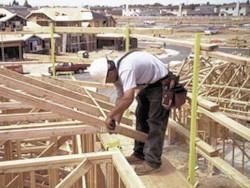Slips, Trips, and Falls
Each year, falls consistently account for the greatest number of fatalities in the construction industry. Slippery surfaces and poor housekeeping account for a large percentage of serious injuries due to slips, trips, and falls.
A number of factors are often involved in falls, including unstable working surfaces, misuse of or failure to use fall protection equipment, and human error. Studies have shown that using guardrails, fall arrest systems, safety nets, covers and restraint systems can prevent many deaths and injuries from falls.
Threshold Height
Where workers on a construction site are exposed to vertical drops of 6 feet or more, OSHA requires employers provide fall protection.
Fall protection is provided in one of three ways before work begins:
- guardrail systems,
- safety net systems, or
- personal fall arrest systems.
If an employee is working on a scaffold, the height requirement for fall protection is 10 feet. Don't let these different threshold heights confuse you.
Knowledge Check Choose the best answer for the question.
2-1. Samuel is working on an elevated platform 15 feet above the ground. What is the threshold height above which Samuel's employer must provide fall protection?
You forgot to answer the question!

